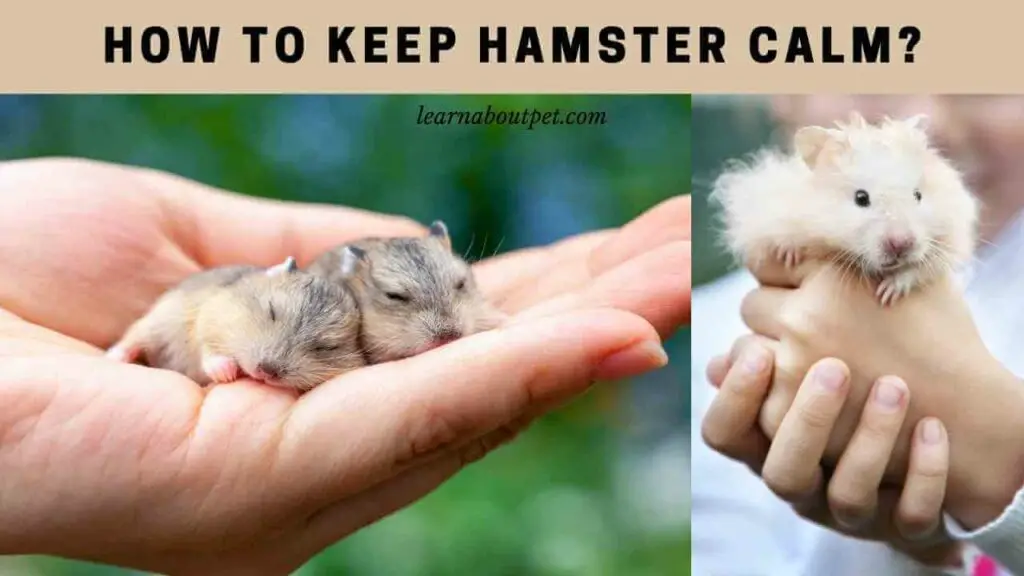Hamsters make excellent pet animals. One of the most typical habits that most individuals observe is that they can become extremely stressed or afraid at any time.
For us, owners, this means we need to make extra sure we’re creating a quiet, stress-free workplace for them. As a result, they will be able to live as comfortably as possible.
So, how to keep Hamster calm? So, because hamsters are easily startled, I performed some studies about how to keep a hamster quiet. Then I integrated it with the techniques we use to keep our hamster quiet.

How To Keep Hamster Calm?
- Maintain a large enough cage in a peaceful environment for your hamster.
- When you’re around them, speak softly and kindly with your hamster.
- Patiently get them used to you so they’ll be more relaxed while you’re around.
- Make sure they have a variety of toys and activities to help them relax.
- Anything new in your hamster’s cage should be introduced slowly.
- Make no abrupt loud noises or movements in their vicinity.
- Have some spots where they can go to get away from it all when they’re feeling anxious.
- Keep larger pets away from the confines of their cage.
- Play soothing music for your hamster.
- Try not to annoy them if you realize they’re stressed.
- When trying to keep your hamster calm, be patient.
Are Hamsters Messy Pets?
No, they are highly clean creatures. The majority of hamsters quickly develop the habit of utilizing only one corner of their cage as a toilet. The rest of the cage will be kept in immaculate condition. Cleaning hamsters get easier as a result of this practice.
On a regular basis, “spot clean” the toilet corner (just scoop out the area with a trowel or dustpan) and replace the discarded bedding. As a result, a thorough cleaning is required significantly less frequently. Furthermore, a properly cared-for hamster is unlikely to emit unwanted odors, making them excellent for the house for those with sensitive noses.
We now have a large selection of specialized equipment to make their care as straightforward as possible. For example, we have bags of dry hamster chow, toys that have been safety approved, and safety cages to keep your hamster in. As a result, there is no aspect of hamster care that should be regarded as difficult to master.
Can Hamster Be Stressed In New Cage?
Is your Hamster stressed in new cage? Yes, they do tend to show this behavior in a new cage. It’s great to have a new hamster cage, but how do you make the transition? If done incorrectly, your hamster may become agitated and begin to exhibit signs of anxiety, concern, and/or discomfort.
This is the absolute last thing any hamster owner wants to happen to their pet.
There are various reasons why switching to a new hamster cage can be difficult. It won’t always be easy, and it’s critical to stay on top of the reasons at all times.
Some of the likely causes are as follows:
- Various Layout
- New Scents and Sights in a Brand-New Setting
You don’t want the shift to be difficult, but if you aren’t patient, it can be.
So, how to keep Hamster calm? You must first purchase the appropriate hamster cage before allowing the hamster to settle in. This is the only way to ensure that the procedure runs smoothly.
13 Smart Ways To Keep Hamster Calm
So how to keep Hamster calm?
- You must ensure that the cage you purchase for your hamster is large enough for them to comfortably do all of their activities. If you don’t, they’ll start to feel hemmed in.
- Keep your hamster in a quiet location so that the loud noises don’t keep them on high alert all of the time.
- When you’re near your hamster and talking to them, remember to speak to them gently so they’re more relaxed around you. Also, when you’re holding your hamster, be sure to do so nicely and carefully.
- Getting your hamster to recognize you will help them remain calm, especially when you are there.
- Hamsters are very busy animals, and if they don’t have enough toys and activities to burn off all of their excess energy, they can grow anxious.
- They enjoy moving around and using their brain, so you’ll need to give them a variety of objects for them to do so, as Hamster Toys, Puzzles, Running wheels.
- You’ll need to provide them with a variety of objects to allow them to move about and use their brain.
- Try not to make too many loud noises or rapid movements when you’re near your hamster. Remember that hamsters are quickly startled.
- When it comes to keeping your hamster relaxed and peaceful, having different areas for them to go when they are terrified or stressed will go a long way.
- If you live in a house with several pets, you should keep them away from your hamster’s cage.
- Another less-known method for keeping your hamster quiet is to have them listen to calming music.
- The last thing you should do when your hamster is stressed is to try to console them. That implies you should avoid petting or touching them in any manner.
- It’s fine if your hamster is constantly terrified because this is quite normal. You’ll just have to be patient with them while they adjust to you and their new surroundings.
How To Calm An Aggressive Hamster?
Hamsters can sometimes display anxious or aggressive behaviors that appear to be unrelated to their environment.
Acting in this manner is not always indicative of your hamster’s personality; there is generally a legitimate reason for the animal’s behavior. how to keep Hamster calm?
Some owners, for example, are unaware that caged hamsters must be domesticated to appreciate being handled by their owners, and that hamsters who have not undergone the taming process may be fearful of associating with humans.
If your hamsters are fighting, how to keep Hamster calm? You’ll almost certainly need to separate them, possibly permanently. If the hamsters are frequently fighting, or if one hamster is blocking another from eating, action must be taken. Some hamsters could also eat their bedding in stress.

How To Calm My Dwarf Hamster Down?
Campbell’s Russian Dwarf is the most popular dwarf hamster of the three types (Campbell’s Russian Dwarf, Siberian Winter White, and Roborovski). They can all be tamed in the same way, regardless of which dwarf hamster you have. Your dwarf hamster will become more friendly toward you, your family, and your friends if you hold him.
How to keep Hamster calm? Allow your dwarf hamster to adjust to his new surroundings. Dwarf hamsters are adorable and loving, so you might want to hold yours right soon. When you bring him home, though, he will require some time to adjust to his new surroundings. Allow him a day or two to investigate his surroundings and figure out where everything is in his cage. It will be easier for you to tame him if he is more at ease in his cage.
Spend time with your dwarf hamster in silence. Spend time near your dwarf hamster’s cage without engaging with him as he adjusts to you and his cage.
Have a conversation with your dwarf hamster. Start talking to your dwarf hamster once he’s settled in for a few days so he can become used to your voice.
How To Calm My Baby Hamster Down?
Try to learn him to cuddle. It’s excellent that he’ll let you take him up and handle him right away, so that’s a bonus. But expecting him to sit on your knee is asking for the impossible, unless you mean he won’t stay long enough on your knee because he wants to explore?
I wouldn’t put a hamster on a couch or bed because all it takes is one fall to seriously damage a hamster. They have poor vision and will fall off the end of anything.
How To Train Your Hamster To Cuddle?
- Place the hamster in its new environment right away.
- Some guidelines.
- Begin by hand-feeding it.
- Slowly acclimate the hamster to being petted as it
- Make sure Hamster is comfortable enough to accept food from you.
- Slowly cup your hands around it and lift.
Can Hamsters Die From Stress?
Your hamsters, like other pets, are not completely stress-free. However, you may be wondering if they can die from stress as well.
What causes hamsters to die? There are a variety of reasons for this, the most common of which is medical. Stress, on the other hand, has a role in their longevity.
How To Keep Hamster Calm? Each hamster reacts to stress uniquely. As a result, you must be aware of any abrupt changes in its behavior, as well as its physical look.
How To Tame A Hamster?
How to keep Hamster calm? You’ll need to spend some time slowly introducing yourself to your pet hamster and allowing it to become acclimated to your presence and smell if you want to tame it. Give your hamster a comfortable environment to live in and let it warm up to you at its speed to help it feel safe.
Use these tips to tame your hamster
- Make a nice home for your hamster.
- Feed the hamster on a regular basis.
- Before touching it, give it a week.
- Assist your hamster in learning to recognize your voice.
- Treats should be given to your hamster.
How To Make My Hamster Happy?
- Allow them to remain nocturnal, During the day, all hamster breeds will sleep. Instead of connecting with them during the day, you should try to do so as much as possible at night.
- Give them a Bath in Sand, Sand baths are a favorite pastime of hamsters. It does, however, clean the hamster by eliminating extra oils from its skin and fur.
- Get yourself a hamster ball. Hamster balls are the classic hamster toy. They are, however, a little more difficult to utilize than you might assume.
- Use only safe accessories. Using the wrong accessories in your hamster’s cage can lead to a lot of injuries. Just because something appears to be safe doesn’t imply it is.
- Place the Cage in an Appropriate Location. You should not simply place your hamster’s cage anywhere. Noise and temperature changes are very bothersome to hamsters.
- Allow for chewing opportunities. The teeth of a hamster, like those of most rodents, are constantly growing. As a result, they must chew frequently to wear down their teeth.
- Allow them to hide, Hamsters dig tunnels to shelter from predators and the scorching desert sun. Most of the time, they are most at ease when they are hidden.
- Don’t Buy Your Hamster a Friend, It is a common misconception that hamsters need a friend to be fulfilled.
- Show Affection – But Not Too Much Humans are very touchy-feely creatures. They want to give their pets hugs and affection.
- Don’t Clean Too Frequently! You don’t want to clean your hamster’s cage too regularly, which may sound paradoxical.
- Make Their Cage Feel As though It Belongs to Them When it comes to making hamsters happy, you should try to create a natural atmosphere for them.
- The importance of enrichment for hamsters cannot be overstated. It is a must, not something you can do on your own time
- Deep Bedding should be provided. Hamsters, as previously said, enjoy burrowing. This is frequently where they sleep and hide their food scraps.

How To Make Your Hamster Like You?
- Get a cage that’s big enough.
- Allow her to adjust to her new circumstances.
- Make a schedule for yourself.
- Allow her to approach you.
- Your hamster should not be punished.
- Find out about your hamster pet personality.
- Make your hamster’s environment more interesting.
As a pet lover, it is your duty to make sure your pet hamsters are comfortable and healthy with you or in their cages. So, please make an active effort to learn about pet more and keep them calm.

Welcome to Learn About Pet. My name is Rajkumar Ravichandran and I love all pets, travel, and amazing food. I write about my passion and personal experience caring for multiple pets in this blog! ❤️
Post Disclaimer
DISCLAIMER: THIS BLOG OR WEBSITE, "Learn About Pet", DOES NOT PROVIDE YOU WITH MEDICAL ADVICE AND IS NOT A SUBSTITUTE FOR MEDICAL ADVICE. ALWAYS GET IN TOUCH WITH YOUR PERSONAL VETERINARIAN AND USE INFORMATION HERE AS GENERAL ADVICE.
The information, including but not limited to, text, graphics, images and other material contained on this website are for informational purposes only. No material on this site is intended to be a substitute for professional veterinary advice, food recommendation, diagnosis, or treatment. Always seek the advice of your veterinarian or other qualified health care provider with any questions you may have regarding a medical condition or for pet food related questions.







